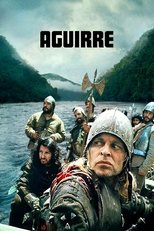Wuchak
Sep 12, 2020
6/10
Conquistador expedition travels down the Amazon to death and madness
After Pizarro’s conquest of the Inca Empire, a megalomaniacal Spanish soldier (Klaus Kinski) leads a group of conquistadores down the Amazon River in early 1561 in search of gold and more conquest.
Werner Herzog’s “Aguirre, the Wrath of God” (1972) mixes the 1541 expeditions of Gonzalo Pizarro & subordinate Francisco de Orellana with the 1560 expedition of the major characters of the film (Aguirre, Ursúa, Don Fernando, Inez and Flores), which left Peru to search for the fabled El Dorado.
This influenced superior movies like “Apocalypse Now” (1979) and “Black Robe” (1991), but “Aguirre” still packs a punch for those who can handle its unconventionality and remote jungle bleakness. It’s a polarizing picture with some loving it and others hating it. I’m in the middle.
I see its greatness: It’s artsy, realistic, haunting and there are potent, unforgettable moments, like the titular character skulking around with a menacing look. But it’s also not as effective as those two future films because it’s rather un-compelling and when the end credits start rolling the viewer is more likely to say “that was different” than be blown away.
The movie runs 1 hour, 35 minutes, and was shot in Peru.
GRADE: B-
